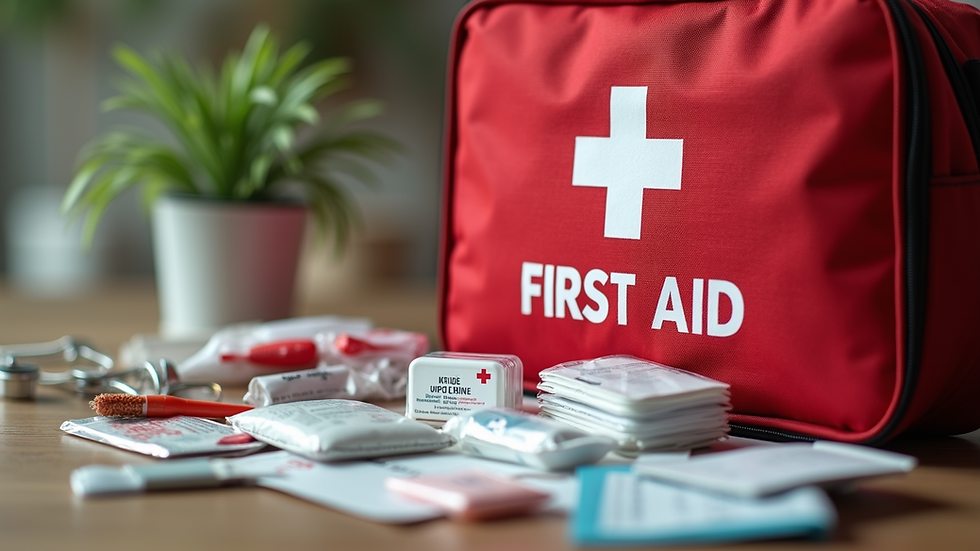The Significance of First Aid at Work
- aly421
- Aug 14, 2023
- 4 min read
According to the Health and Safety Executive in 2021-2022, 123 workers lost their lives due to work-related accidents and a further 565,000 workers suffered non-fatal injuries.
The Significance of First Aid at Work
Ensuring the safety and wellbeing of employees is of maximum importance in every workplace. Whilst preventive measures such as training, installing equipment and creating policies are implemented to minimise risks and prevent accidents, sudden incidents can still occur. This is where ‘First Aid at Work’ becomes critically important.
For any comprehensive workplace safety programme, First Aid is an essential component. To understand why this is so crucial, this article explains the purpose of first aid at work and explains how important first aid training is.
How do we define First Aid?
First aid refers to the immediate medical attention provided to a patient right after an accident or emergency, at the location where it happened. It involves short-term, temporary treatment aimed at minimising pain and bleeding, preserving life or preventing the condition from worsening. While basic medical training is usually required to administer first aid, anyone can sign up for a first aid course to learn the essential skills.
The Importance of First Aid at Work
First aid at work is significantly important for a number of reasons. Studies have shown that promptly applying first aid can dramatically increase survival rates for serious injuries or illnesses. For instance, in cases of cardiac arrest, every minute without CPR administration reduces the chances of survival by 10%. Additionally, according to data from 2021-2022, 123 workers lost their lives due to work-related accidents, and a further 565,000 workers suffered non-fatal injuries. Source: https://www.hse.gov.uk/statistics/causinj/kinds-of-accident.pdf
From this data, it is evident that the purpose of first aid at work is to save lives and safeguard the well-being, of both employees and employers, in the event an accident occurs.
Here are some reasons why learning first aid should be at the top of every employers list.
· First aid training can mean the difference between life and death. A Red Cross survey showed a staggering 59% of deaths from injuries would have been preventable had first aid been given before the emergency services arrived.
· First aid reduces recovery time and can mean the difference between them having a short term or more permanent disability.
· First aid can prevent a bad situation from getting worse. Consider someone who is seriously bleeding from a deep cut. Without intervention, they could suffer severe blood loss. By applying pressure using simple first aid techniques, you can prevent a medical emergency from rapidly deteriorating and stabilise the patient until further medical help arrives. The same with burns, where prompt and appropriate treatment not only reduces damage, but also promotes healing, reducing pain, scarring and long term damage from the injury.
· Injuries such as a bumped head, bruised knee or sprained ankle can be better managed with the correct procedure such as competent bandaging, rest or swelling reduction with a wrapped ice pack.
· It teaches to prioritise injuries and gives the knowledge to establish whether someone needs further care and whether that care should be given by the GP, at a hospital or immediate paramedic intervention.
· Knowing how to respond helps people stay calm in an emergency situation, and allows emotional support to the patient to be given and prevent them from panicking. Knowing how to physically move someone in pain, support their injuries and administer appropriate bandaging and dressings can also greatly reduce the amount of pain they experience.
· Staying with the patient until the emergency services arrive means you can convey vital information about how the patient sustained the injury or information about their condition. This information is vital for the effective treatment of the patient and can aid the patient’s treatment and recovery.

· Learning first aid and becoming alert to potential hazards and medical issues increases our health awareness and allows us to take better care of ourselves and our employees.
Is First Aid Training a legal requirement in the workplace?
The Health and Safety (First-Aid) Regulations (1981) govern the obligation for first aid at work, although they do not provide specific rules for workplace safety. The regulations require employers to provide adequate and appropriate equipment, facilities and personnel to ensure their employees receive immediate attention if they are injured or taken ill at work.
As an employer, it is your responsibility to set the standard for first aid in your workplace. Although first aid training is not a legal requirement, providing specific guidance for your business ensures that your employees receive the best care possible in case of an accident and helps prevent legal repercussions.
Having the correct first aid provision in the workplace is not only a legal requirement, it is incredibly important for the safety of you and your employees. Our easy to use First Aid Requirements Calculator has 3 simple steps that will only take a few minutes to complete and will provide a report on what you need. https://bit.ly/43ZwM8q
At Plan for Safety, we take workplace health and safety seriously, and we believe that every high-risk industry should have fundamental first aid training to ensure the safety of both employees and employers. We offer a wide range of first aid training courses, ranging from ½ day to 3 days in length that are tailored to your workplace needs.
Details about all our first aid courses can be found at: https://www.planforsafety.co.uk/first-aid-courses. For further information please call us on 020 3598 0713 or email: info@planforsafety.co.uk
“Together we can help save lives”.





Comments